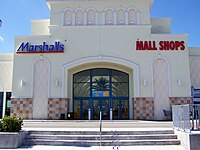The Mall at 163rd Street

The mall's east entrance
|
|
| Location |
North Miami Beach, Florida |
|---|---|
| Coordinates | 25°55′39″N 80°10′24″W / 25.927418°N 80.173298°WCoordinates: 25°55′39″N 80°10′24″W / 25.927418°N 80.173298°W |
| Address | 1421 Northeast 163rd Street |
| Opening date | November 1, 1956 |
| Developer | Food Fair Properties |
| Management | Brixmor Property Group |
| Owner | Brixmor Property Group |
| Architect | Gamble, Pownall & Gilroy |
| No. of stores and services | 50+ |
| No. of anchor tenants | 5 |
| Total retail floor area | 373,273 square feet (34,678.2 m2) |
| No. of floors | 3 |
The Mall at 163rd Street is an enclosed shopping mall and power center in North Miami Beach, Florida. From its opening as an open-air shopping center in 1956, it has been converted into an enclosed mall, but was later redeveloped as a combination of both formats. The mall's anchors are The Home Depot, Marshalls, Ross, and Wal-Mart Supercenter.
The mall opened on November 1, 1956, as The 163rd Street Shopping Center, anchored by a Raymond Loewy-designed Burdines and later, Richard's. In addition, it sported forty-nine outlets, including Food Fair (later Pantry Pride), J. C. Penney, M and M Cafeteria, Walgreens, and Woolworth.
Wometco 163rd Street Theatre served as an outparcel, and by 1961, was doubled as the 163rd Street & Patio Theater. In February 1971, Jordan Marsh opened a three-story location at the shopping center's east wing.
Until the late 1970s, the center court fronting Burdines had provided countless kiddie rides, which were all encircled by a train track. A go-kart track also existed in the north parking lot, but was destroyed by Hurricane Cleo and never rebuilt.
From 1980 to October 1982, the shopping center was converted into a climate-controlled enclosed mall. Colossal metal arches were flanked over the main plaza that the stores resided along, and a white, translucent, Teflon-coated canvas was placed over them. Richard's, which closed on January 11, 1980, as part of a chain-wide closure, was fashioned into a three-floor atrium. The upper level became a food court while the lower level allowed for the expansion of Spec's Music as Spec's Metro. It was at this time the mall was rebranded to its current name, however the mall's transformation was often called The Miracle on 163rd Street.
...
Wikipedia
